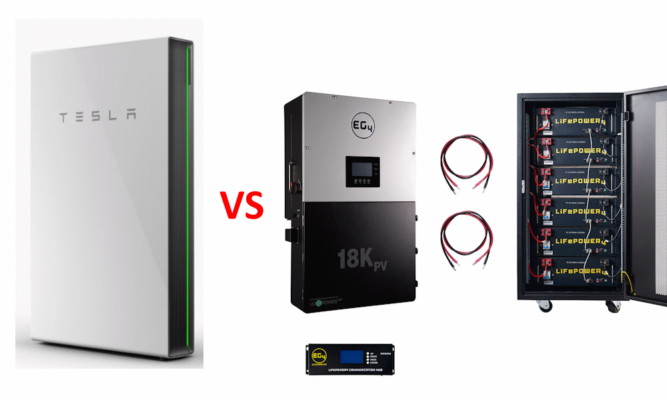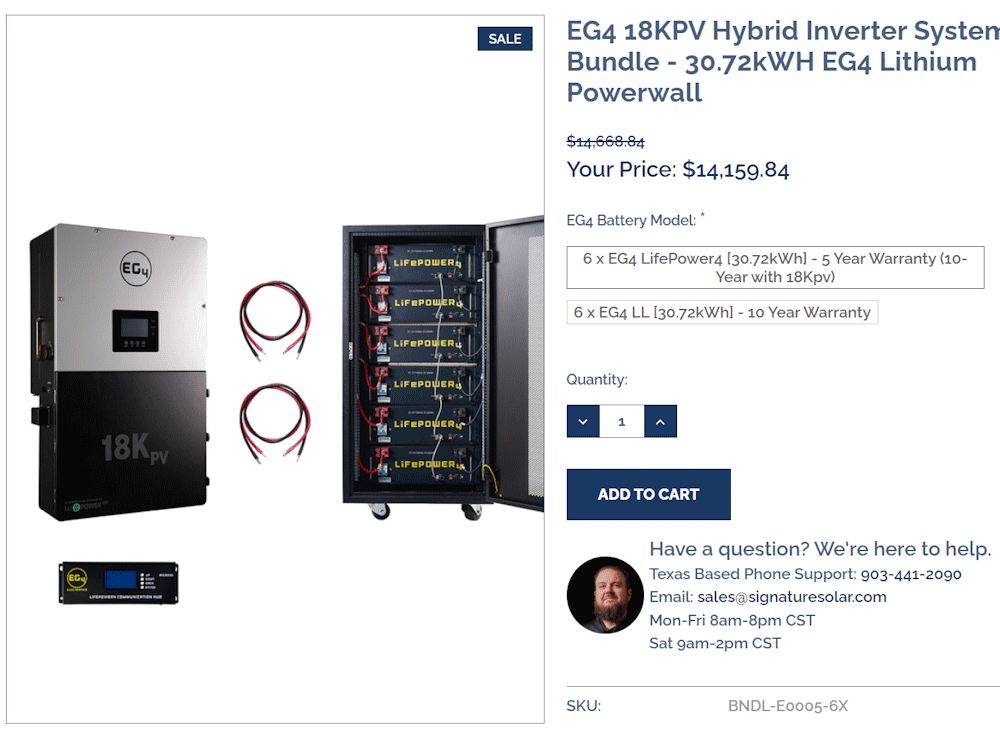Considering Home Energy Storage

We recently purchased a tear-down with the goal of building a new passive house on the lot. Naturally, there will be will be a massive solar array on the house, and probably on the detached garage as well. Picking a panel fairly easy because the differences in PV (photovoltaic) products seems to mostly come down to warranty period. Energy storage is a much more complicated decision though. There seem to be two basic approaches to solving this problem, and a whole-lotta OEMs playing in the space.
I don’t have an answer yet, but I am leaning heavily in one direction. It confuses me a little that it isn’t more common. Explaining what the options are is one of the goals of this post.
Player One: All-In-One (AIO) battery inverter
It might be sampling bias, but the AIO battery solutions, like Tesla’s Powerwall, seem to be The Way home energy storage gets done. Maybe it’s because of where I live (suburbs of Chicago) and who is vocal on the topic in the forums and channels I follow. I don’t know. Assuming that it is the case, I understand why builders and installers like them. They are generally more consumer friendly, look cleaner, because it’s AIO probably less complicated to install, and key point have very high margins facilitated by almost non-existent transparency around price (Tesla is a notable exception). I expect that you all know what this is, but just in case I’m going to describe how it works at a high-level. The AIO batteries all include a series of DC batteries, usually in the 5-15kWh range, a AC/DC inverter to convert the input (AC) for storage (DC), and back again for output (AC), and a controller to provide orchestration and monitoring.
There are many trade-offs associated with this approach, and that’s why I prefer the other option. Let’s break down some players, but nowhere near all the players, before getting to that.
- Tesla Powerwall+: I’m not sure if it’s completely fair to call Tesla the OG for this product category, but they definitely put it on the map. Interestingly they are the only vendor that has any real price transparency. Unfortunately, the battery chemistry isn’t ideal for home energy storage otherwise I would probably choose Powerwall+ over the other options in the category.
- Capacity: 13.5kWh
- Continuous Output: 5-7kW? (Tesla has different output numbers for on/off grid)
- Warranty: 10 years
- Cost: $8,700
- Round-trip Efficiency: 90%
- Chemistry: Lithium-ion
- Enphase Energy IQ10: Enphase has a few options, none of them are great. Frankly, I don’t know why anyone would buy their solution. They lag the competition in every metric, except price (which lacks transparency). Even the new IQ5, which you can’t really get yet, sucks in comparison to the other options.
- Capacity: 10.5kWh
- Continuous Output: 3.84kW
- Warranty: 10 years
- Cost: $8,000-$10,000
- Round-trip Efficiency: 89%
- Chemistry: LFP (LiFePO4)
- SolarEdge BAT-10K1PS0B-01: Lithium-ion is a bummer, and the round-trip number is suspect. Inverter losses are usually 3-4%, so doable if their inverter is awesome, but I am not confident that we’d see that in reality with the double conversion. Pricing transparency is also lacking
- Capacity: 10kWh
- Continuous Output: 5.0kW
- Warranty: 10 years
- Cost: ~$9,000 (best guess)
- Round-trip Efficiency: 94.5%
- Chemistry: Lithium-ion
- LG ESS Home 8: Solid specifications, but the lack of pricing transparency is troubling.
- Capacity: 14.4kWh
- Continuous Output: 7.5kW
- Warranty: 10 years
- Cost: $10,000-$12,000?
- Round-trip Efficiency: 90%
- Chemistry: LFP (LiFePO4)
- FranklinWH aPower: I really struggled to find solid pricing data, and for what I did find, I struggle to see why this would be the choice over some of the other options.
-
- Capacity: 13.6kWh
- Continuous Output: 5kW
- Warranty: 12 years
- Cost: $11,000-$18,000?
- Round-trip Efficiency: 89%
- Chemistry: LFP (LiFePO4)
-
Trade-offs:
- Cost: All the numbers above don’t include installation or other hardware that might be required to make it work. Tesla is the only vendor that I could find those numbers easily, so we’ll roll with it and assume that the others will be similar. It worth noting that the installation price below varies with the number of AIO installed. It was $5,800 for one, so clearly it makes sense to get it done in one go if you can afford it with this approach.

- Installation complexity: I think this is probably where the AIO have an advantage, but I haven’t talked about it with an actual installer to nail it down. It just makes sense given how they interact with the electrical system at your house that the complexity would be lower, but I don’t think that’s reflected in the installation price.
- User friendliness: This is a much easier thing to call for AIO. The apps for most of these battery systems are sleek and professional in a way that the other’s aren’t.
- Power output: This one is trickier because the output is a function of scale. Totally makes sense given that the inverter is in the system, so as you add more batteries you get more output capability. The problem is that there’s no flexibility to add capacity in one area without also adding it in the other. This drives up cost.
- Who is this for: This is probably the better option if you already have an AC coupled PV array, don’t want PV, don’t want to think about it (no one gets fired for choosing Tesla), or don’t need more than the absolute bare minimum for home energy storage.
Player Two: Hybrid inverter + server rack batteries
This is the more complicated, but not the most complicated, way to get this done. You can absolutely do it using stand-alone inverters, charge controllers, etc., but it seems like using the hybrid device that manages all of the orchestration between the grid, batteries, and PV seems to be the right way to do this now. Definitely the easier way to get it done.
- EG4 18K:
- Capacity: 100kWh+. If there is a storage limit, I wasn’t able to find it.
- Continuous Output: 12kW
- Warranty: 10 years
- Cost: $5,599
- Round-trip Efficiency: ~94.5%
- Sol-Ark 15K:
- Capacity: 100kWh+. If there is a storage limit, I wasn’t able to find it.
- Continuous Output: 12kW
- Warranty: 10 years
- Cost: $6,999
- Round-trip Efficiency: ~93%
- EG4-LifePower4 (e.g battery, there’s not much difference in server rack batteries):
- Capacity: 30.72kWh (5.12kWh/battery)
- Warranty: 5 year with Sol-Ark, 10 years with EG4 18K
- Cost: $8,703 ($1,359/battery)
- Round-trip Efficiency: 99%
Trade-offs:
- Cost: This is far-and-away the more cost effective solution. If we assume that installation costs the same the Powerwall, then it’s ~$22,000 vs $35,000. The Tesla solution does have more capacity (~40kWh vs ~30kWh), but we could add another 30kWh to get to 60, and still come in cheaper than the Powerwall. Adding capacity is easy as well. So if I wanted to add that 30kWh at a later date, it would require running two wires between the existing rack and the new one. I would probably hire a licensed electrician for an hour to do that, versus the thousands of dollars it would cost to add additional AIO capacity.

- Installation complexity: Installing a hybrid system is probably more complicated, but I have a hard time seeing how it would be more than $8,000 complicated on a new house build. But it might be more than that if existing infrastructure is in place. To function correctly, the hybrid system would be installed between the meter and service panel. From what I’ve found, you want one of them per 200A (or less) panel, so complexity and cost will scale with the inverter count.
- User friendliness: Both the EG4 and Sol-Ark have a network accessible UI. Neither seems to have much polish to it; think circa-2010 Wi-Fi router. Personally, I’m not sure I care as long as the data is present. I think that in both cases the network connectivity also provides remote troubleshooting by their support if there is an issue. Which is something I need to verify, but the forums on these topics indicate that support for both is very good. Sol-Ark might have the edge because it’s a US company and they provide support. EG4 is supported in the US by the US distributor.
- Power output: Capability and capacity are decoupled at the battery. They are not decoupled on the PV side, but there is some flexibility to DC couple and AC couple (on the generator input) simultaneously if you overrun the 18K DC input limit. I would like to start with around 30kW of PV, which will put me over the limit for a single unit, but given that the house will be all electric with at least 400A service, if we go this way we’ll be putting two of these in which will also provide 24kW of output.
Lastly, I would like to explain my battery chemistry concerns in more detail. There is room for a diversity of opinion around this point, and there isn’t a single answer to this question, but I don’t think it’s a good idea to use Lithium-ion batteries for home energy storage in most scenarios. Lithium-ion batteries have many strengths. Those strengths make them great for phones, tablets, and cars where weight and low temperature performance matter more than the negatives; which includes risk of thermal runaway, and the ~20-80% usable bounds of the technology. LFP is much more resilient to using the full capacity of the battery, it doesn’t really matter how much it weighs, it’s cheaper, and in many cases the temperature performance won’t be an issue. If it is, some batteries have warmers built in. In my case, I plan to put everything in the basement, so temperature control won’t be a problem.
I haven’t made up my mind yet. I don’t know how much convincing it will take with our architect/builder to go this way. I don’t even know if I’m willing to choose the more complicated, cheaper, more flexible option over the “safe” one. Putting all this down in an attempt to find clarity was another goal. That didn’t work out, I’m still conflicted :D.
